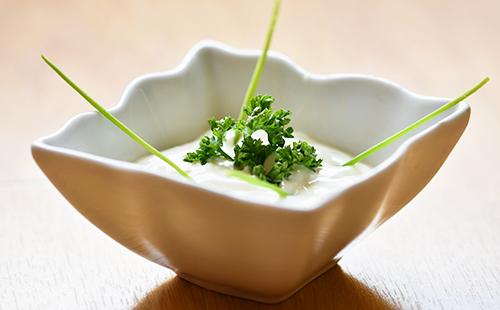In modern cooking, there are thousands of options for tartar sauce, because every chef seeks to add some unique flavor to the recipe. For example, the famous Auguste Escoffier created a truly French sophisticated recipe, involving the use of onion puree. But Michel Roux refused a uniform texture and preferred to add whole crisp pieces of onion. Perhaps this is the main charm.
Recipes Composition of tartar sauce
Tartar sauce is ideal for fish, seafood, meat and even vegetables. A delicate base gives the dish the necessary juiciness, and pickles and greens - a special sharpness and piquancy.
Classic
Features. The classic tartar sauce recipe is a good basis for culinary experiments. By adding different components to it, you can achieve new unexpected tastes. The sauce will add piquancy to tender fish fillets or give fresh notes to aromatic meat dishes.
You will need:
- two boiled eggs;
- two raw yolks;
- a third of a glass of olive oil;
- as much sour cream;
- a pair of large feathers of green onions;
- medium-sized pickled cucumber;
- 50 g pickled champignons;
- a tablespoon of mustard;
- a little lemon juice (can be replaced with vinegar);
- salt and sugar at your discretion.
Cooking
- Mash boiled and raw yolks with mustard until smooth.
- Beat the mass intensively with a whisk, slowly pouring oil into it. Continue to work with a whisk until the mass becomes uniform and dense, like mayonnaise.
- Finely chop egg whites, onions, cucumbers and mushrooms.
- Mix the crushed components with sour cream. Add salt, sugar, lemon juice.
- Combine the sour cream and egg mixture and mix until smooth.
With mayonnaise
Features. If the guests are already on the doorstep and you don’t have time to set the table at home, instead of the classic tartare, you can prepare tartar sauce with mayonnaise in a matter of minutes. You do not have to grind and beat anything, because in fact, mayonnaise - this is the egg-oil base. The advantage of this option is not only in simplified technology, but also in taste. The result is a sharper and more intense taste than in the case of a recipe for tartar sauce with sour cream.
You will need:
- a glass of lean or lean mayonnaise;
- large pickled cucumber;
- a couple of tablespoons of capers (can be replaced with olives);
- five cloves of garlic;
- a tablespoon of chopped dill;
- a tablespoon of mustard.
Cooking
- Chop the cucumbers and herbs, squeeze the garlic or grate on a fine grater.
- Capers can be left intact. If you use olives, cut them across.
- Stir mayonnaise with mustard until smooth.
- It remains only to connect all the components.
Cheesy
Features. Homemade tartar sauce will become thick and rich if you add cream cheese to it. Such a treat will complement chicken or fish fillet well. Cheese tartare can be used for sandwiches.
You will need:
- a glass of mayonnaise;
- 100 g of processed cheese;
- three pickled cucumbers;
- two cloves of garlic;
- half a glass of lemon juice.
Cooking
- Add lemon juice, squeezed garlic to mayonnaise and mix well.
- Chop the cucumbers.
- Combine all the ingredients and let the sauce brew.

Dietary
Features. Dietary recipe for tartar sauce involves the use of light natural yogurt. It fits into the concept of proper nutrition. A fresh and spicy note of mint with aromatic fresh cucumber will fill even the freshest dietary food with bright flavors.
You will need:
- large fresh cucumber;
- clove of garlic;
- a glass of yogurt without additives;
- a tablespoon of mayonnaise;
- a teaspoon of lemon juice;
- dried mint and salt to taste.
Cooking
- Whisk the whisk with yogurt with mayonnaise, lemon juice, salt and mint.
- Squeeze the garlic into the yogurt mixture.
- Finely chop the cucumber and add to the sauce.
8 secrets from cooks
Sauce is a delicate and delicate substance that can make a dish sparkle with new colors and make a festive meal out of ordinary food. But to create a successful tartare, it is important not only a combination of tastes, but also knowledge of some culinary subtleties. There are eight tips from cooks:
- Observe storage periods. In a plastic or ceramic dish, the sauce can be stored in the refrigerator for up to two days. If you want to extend the shelf life of the product to five days, pour it into a sterilized glass jar with a tight lid.
- Do not cut too finely. One of the key features of tartar is that, against a background of a gentle liquid base, fragments of vegetables, herbs and other additives are felt well.
- Pause. Ideally, before serving, the sauce should be infused for about half an hour on the bottom shelf of the refrigerator, so that all the ingredients are saturated with each other's tastes. Judging by the reviews of the hostesses, the best taste is revealed in a day.
- Onion - before serving. Green onions, being in the sauce, will quickly give it their specific aroma, and itself will remain tasteless. Therefore, this component is best introduced into the tartar just before serving.
- Individual proportions. The ratio of components in the recipe is recommended. You can combine the liquid part of the sauce with solid additives at your discretion.
- Watch the quality of the eggs. Before preparing tartar sauce at home, toss the chicken egg into a glass of water. If it is fresh, it will fall to the bottom. If the eggs do not pass the test, use them only in boiled form.
- Do not rush to salt. This can only be done after the sauce is infused for at least half an hour. During this time, cucumbers, capers and olives will give part of the salt base. After trying, you will understand whether you need to season the dish additionally.
- Flavorful with garlic. Add this component only to the sauce that you plan to serve with meat and fish dishes. For vegetables, this spice is too sharp.
Despite the fact that the first step-by-step recipe for tartare sauce is given in French culinary literature, this dish has far from French roots.The purpose of the campaigns of Louis IX was not only the conquest of territories, but also the borrowing of traditions, including culinary ones. The idea of cold milk sauce with herbs and pickles was borrowed from the Tatars. The dish was carefully processed and acquired a unique French charm. Nevertheless, specific pungency and piquancy betrays the tough character inherent in the Tatar people.

